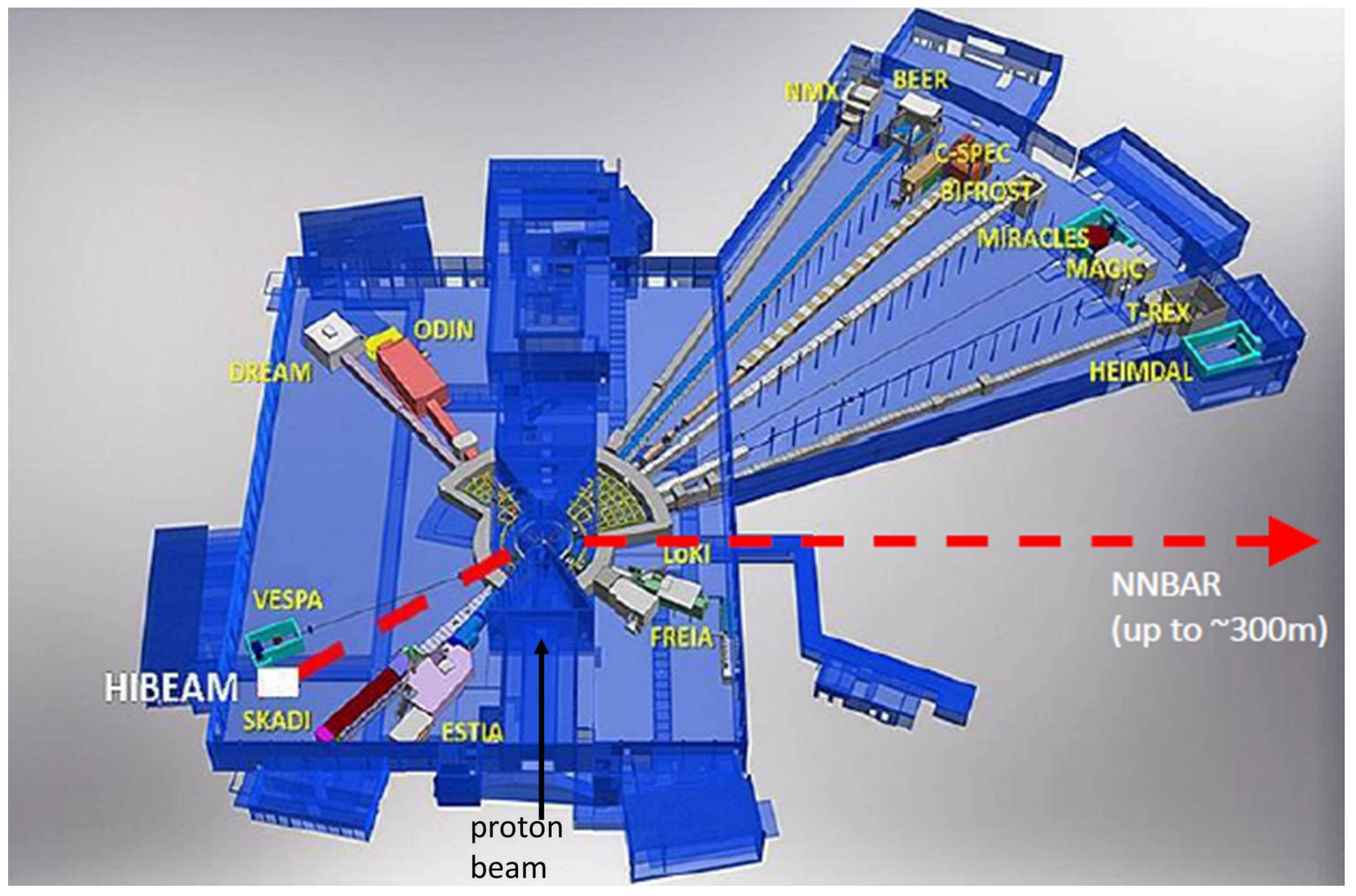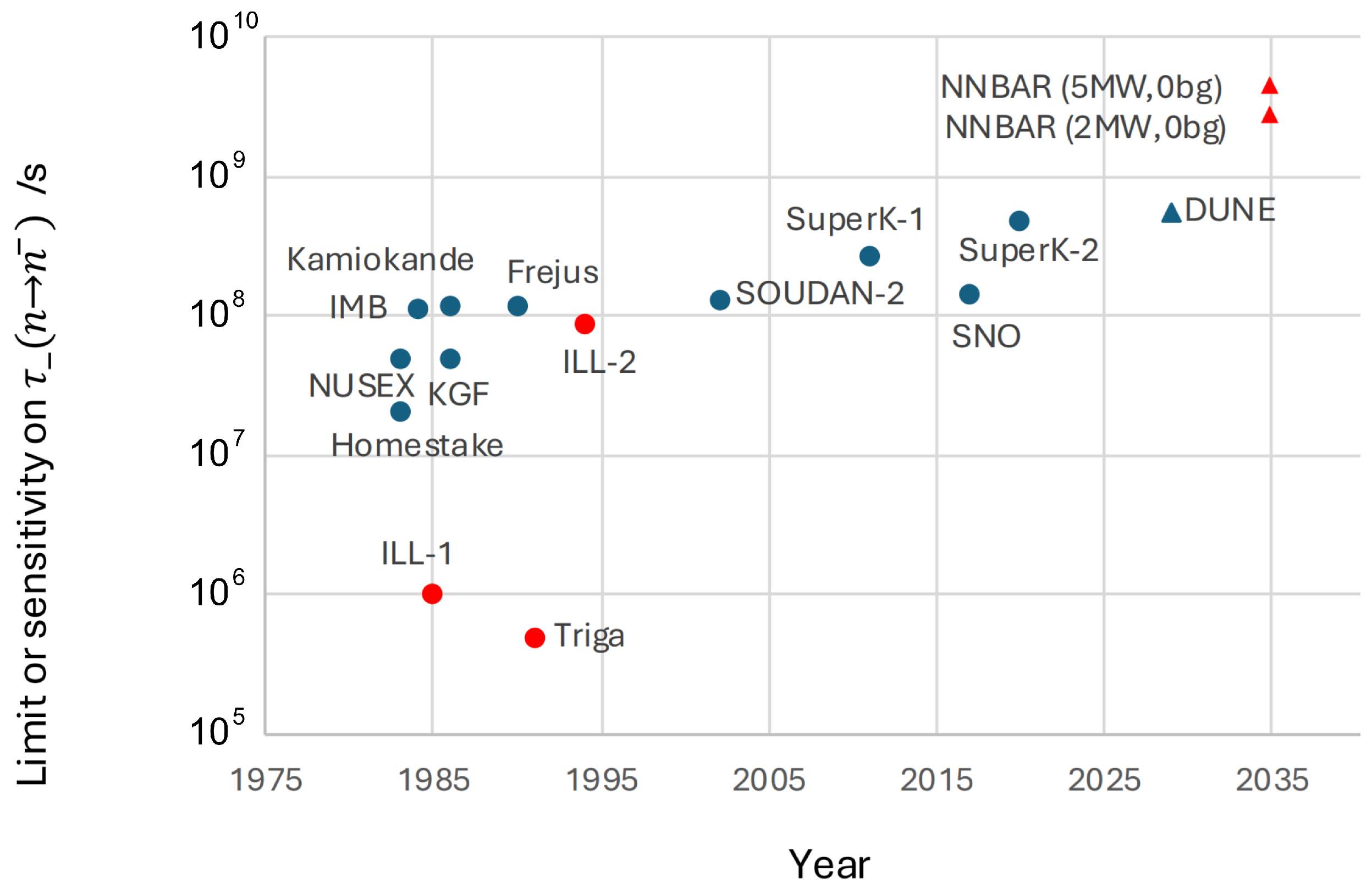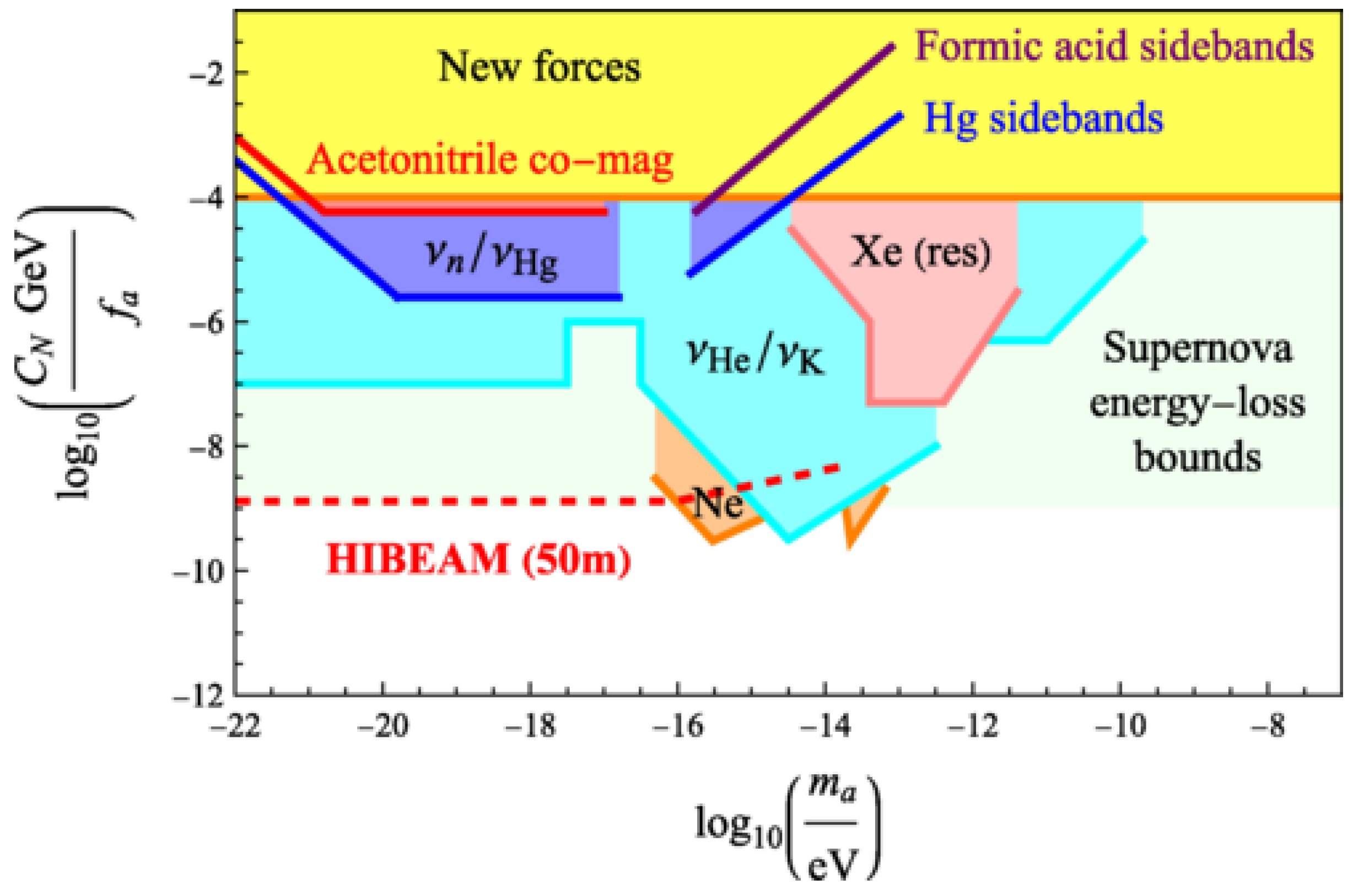The HIBEAM Experiment †
Abstract
1. Introduction
2. The HIBEAM/NNBAR Program
2.1. The NNBAR Experiment
2.2. The HIBEAM Experiment
3. Summary and Outlook
Funding
Data Availability Statement
Conflicts of Interest
References
- Sakharov, A. Violation of CP invariance, C asymmetry, and baryon asymmetry of the universe. Sov. Phys. Usp. 1991, 34, 392. [Google Scholar] [CrossRef]
- Calibbi, L.; Ferretti, G.; Milstead, D.; Petersson, C.; Pöttgen, R. Baryon number violation in supersymmetry: n- oscillations as a probe beyond the LHC. J. High Energy Phys. 2016, 5, 144, Erratum in J. High Energy Phys. 2017, 10, 195. [Google Scholar] [CrossRef]
- Phillips, D.G., II; Snow, I.I.W.M.; Babu, K.; Banerjee, S.; Baxter, D.V.; Berezhiani, Z.; Bergevin, M.; Bhattacharya, S.; Brooijmans, G.; Castellanos, L.; et al. Neutron-Antineutron Oscillations: Theoretical Status and Experimental Prospects. Phys. Rept. 2016, 612, 1–45. [Google Scholar] [CrossRef]
- Baldo-Ceolin, M.; Benetti, P.; Bitter, T.; Bobisut, F.; Calligarich, E.; Dolfini, R.; Dubbers, D.; El-Muzeini, P.; Genoni, M.; Gibin, D.; et al. A New experimental limit on neutron - anti-neutron oscillations. Z. Phys. C 1994, 63, 409–416. [Google Scholar] [CrossRef]
- Addazi, A.; Anderson, K.; Ansell, S.; Babu, K.S.; Barrow, J.L.; Baxter, D.V.; Bentley, P.M.; Berezhiani, Z.; Bevilacqua, R.; Biondi, R.; et al. New high-sensitivity searches for neutrons converting into antineutrons and/or sterile neutrons at the HIBEAM/NNBAR experiment at the European Spallation Source. J. Phys. G 2021, 48, 070501. [Google Scholar] [CrossRef]
- Abele, H.; Alekou, A.; Algora, A.; Andersen, K.; Baeßler, S.; Barron-Pálos, L.; Barrow, J.; Baussan, E.; Bentley, P.; Berezhiani, Z.; et al. Particle Physics at the European Spallation Source. Phys. Rept. 2023, 1023, 1–84. [Google Scholar] [CrossRef]
- Santoro, V.; Abou El Kheir, O.; Acharya, D.; Akhyani, M.; Andersen, K.H.; Barrow, J.; Bentley, P.; Bernasconi, M.; Bertelsen, M.; Beßler, Y.; et al. HighNESS conceptual design report: Volume II. The NNBAR experiment. J. Neutron Res. 2023, 25, 315–406. [Google Scholar] [CrossRef]
- Santoro, V.; Milstead, D.; Fierlinger, P.; Snow, W.M.; Barrow, J.; Bartis, M.; Bentley, P.; Björk, L.; Brooijmans, G.; de la Cour, N.; et al. The HIBEAM program: Search for neutron oscillations at the ESS. arXiv 2023, arXiv:2311.08326. [Google Scholar]
- Backman, F.; Barrow, J.; Beßler, Y.; Bianchi, A.; Bohm, C.; Brooijmans, G.; Broussard, L.J.; Calen, H.; Cederkäll, J.; Damian, J.I.M.; et al. The development of the NNBAR experiment. J. Instrum. 2022, 17, P10046. [Google Scholar] [CrossRef]
- Gonzalez, F.M.; Rock, C.; Broussard, L.J.; DeBeer-Schmitt, L.; Frost, M.J.; Heilbronn, L.; Iverson, E.B.; Kamyshkov, Y.; Kline, M.; Milstead, D.; et al. Improved limits on n→n’ transformation from the Spallation Neutron Source. Phys. Rev. D 2024, 110, 072022. [Google Scholar] [CrossRef]
- Dunne, K.; Meirose, B.; Milstead, D.; Oskarsson, A.; Santoro, V.; Silverstein, S.; Yiu, S.C. The HIBEAM/NNBAR Calorimeter Prototype. J. Phys. Conf. Ser. 2022, 2374, 012014. [Google Scholar] [CrossRef]
- Barrow, J.; Brooijmans, G.; Damian, J.I.M.; DiJulio, D.; Dunne, K.; Frost, M.; Golubeva, E.; Kamyshkov, Y.; Kittelmann, T.; Klinkby, E.; et al. Computing and Detector Simulation Framework for the HIBEAM/NNBAR Experimental Program at the ESS. EPJ Web Conf. 2021, 251, 02062. [Google Scholar] [CrossRef]
- Yiu, S.-C.; Meirose, B.; Barrow, J.; Bohm, C.; Brooijmans, G.; Dunne, K.; Golubeva, E.S.; Milstead, D.; Nepomuceno, A.; Oskarsson, A.; et al. Status of the Design of an Annihilation Detector to Observe Neutron-Antineutron Conversions at the European Spallation Source. Symmetry 2022, 14, 76. [Google Scholar] [CrossRef]
- Abe, K.; Bronner, C.; Hayato, Y.; Ikeda, M.; Imaizumi, S.; Ito, H.; Kameda, J.; Kataoka, Y.; Miura, M.; Moriyama, S.; et al. [Super-Kamiokande]. Neutron-antineutron oscillation search using a 0.37 megaton-years exposure of Super-Kamiokande. Phys. Rev. D 2021, 103, 012008. [Google Scholar] [CrossRef]
- Abi, B.; Acciarri, R.; Acero, M.A.; Adamov, G.; Adams, D.; Adinolfi, M.; Ahmad, Z.; Ahmed, J.; Alion, T.; Alonso Monsalve, S.; et al. [DUNE], Deep Underground Neutrino Experiment (DUNE), Far Detector Technical Design Report, Volume IV: Far Detector Single-phase Technology. J. Instrum. 2020, 15, T08010. [Google Scholar] [CrossRef]
- Fierlinger, P.; Holl, M.; Milstead, D.; Santoro, V.; Snow, W.M.; Stadnik, Y.V. Proposal for a Ramsey Neutron-Beam Experiment to Search for Ultralight Axion Dark Matter at the European Spallation Source. Phys. Rev. Lett. 2024, 133, 181001. [Google Scholar] [CrossRef]




Disclaimer/Publisher’s Note: The statements, opinions and data contained in all publications are solely those of the individual author(s) and contributor(s) and not of MDPI and/or the editor(s). MDPI and/or the editor(s) disclaim responsibility for any injury to people or property resulting from any ideas, methods, instructions or products referred to in the content. |
© 2025 by the author. Licensee MDPI, Basel, Switzerland. This article is an open access article distributed under the terms and conditions of the Creative Commons Attribution (CC BY) license (https://creativecommons.org/licenses/by/4.0/).
Share and Cite
Burgman, A., on behalf of the HIBEAM/NNBAR Collaboration. The HIBEAM Experiment. Particles 2025, 8, 6. https://doi.org/10.3390/particles8010006
Burgman A on behalf of the HIBEAM/NNBAR Collaboration. The HIBEAM Experiment. Particles. 2025; 8(1):6. https://doi.org/10.3390/particles8010006
Chicago/Turabian StyleBurgman, Alexander on behalf of the HIBEAM/NNBAR Collaboration. 2025. "The HIBEAM Experiment" Particles 8, no. 1: 6. https://doi.org/10.3390/particles8010006
APA StyleBurgman, A., on behalf of the HIBEAM/NNBAR Collaboration. (2025). The HIBEAM Experiment. Particles, 8(1), 6. https://doi.org/10.3390/particles8010006







